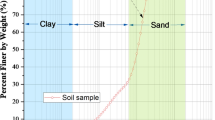Abstract
The image of quicksand merciless swallowing a victim has inspired the fantasy of kids and helped writers and moviemakers to get rid of evil figures. Is this really possible? This is still disputed since till today it is not even clear what quicksand exactly is. In soil mechanics, the “quick-condition” is usually described as a liquefaction due to high water pressure essentially possible with any soil. However, previous studies have detected anomalous rheological properties from natural quicksand. Pushed by these contradicting points of view we set off to Lençois Maranhenses in North-East Brazil, where quicksands are common, to investigate rheology and strength in situ. We found that along very quiet drying lakes cyanobacteria cement an impermeable crust above a suspension of grains. Beyond a critical pressure, the crust fails releasing water from the collapsing colloidal structure and radically changing the depth dependence of the shear strength from a constant to a linear function. The sedimenting solid fraction and the rapid increase of shear strength can indeed trap an intruder endangering his life if the basin is sufficiently deep. As opposed to some previous studies, we find that this quicksand condition cannot be restored once it has collapsed. Finally, we also show some preliminary results from a contact dynamics model specially designed to mimic the living quicksand behavior.
Similar content being viewed by others
References
Freundlich H., Juliusburger F.: Quicksand as a thixotropic system. T. Faraday Soc. 31, 769–773 (1935)
Matthes G.H.: Quicksand. Sci. Am. 188, 97–102 (1953)
Bahlmann L., Klaus S., Heringlake M., Baumeier W., Schmucker P., Wagner K.F.: Rescue of a patient out of a grain container: the quicksand effect of grain. Resuscitation 53, 101–104 (2002)
Yamasaki S.: What is quicksand? Sci. Am. 288, 95–95 (2003)
Lohse D., Rauhe R., Bergmann R., van der Meer D.: Creating a dry variety of quicksand. Nature 432, 689–690 (2004)
Smith E.R.: The lifting effect of quicksand. Ohio J. Sci. 46, 327–328 (1946)
Lambe T.W., Whitman R.V.: Soil Mechanics. Wiley, New York (1969)
El Shamy U., Zeghal M.: Coupled continuum-discrete model for saturated granular soils. Eng. Mech. 131, 413–426 (2005)
Craig R.F.: Soil Mechanics. E & FN Spon, New York (1997)
Huerta D.A., Sosa V., Vargas M.C., Ruiz-Suarez J.C.: Archimedes’ principle in fluidized granular systems. Phys. Rev. E 72, 031307 (2005)
Kruszelnicki K.: And the earth did swallow them up!. New Sci. 152, 26–29 (1996)
Khaldoun A., Eiser E., Wegdam G.H., Bonn D.: Liquefaction of quicksand under stress. Nature 437, 635 (2005)
Schwammle V., Herrmann H.J.: Solitary wave behaviour of dunes. Nature 426, 619–620 (2003)
Parker W.R.: Quicksand structures in bedded tuffs of great langdale westmorland. Nature 210, 1247 (1966)
Clayton C.R.I., Matthews M.C., Simons N.E.: Site Investigation. Blackwell Science, Oxford (1995)
Danin A.: Plant species—diversity and plant succession in a sandy area in the northern negev. J. Arid Environ. 167, 409–409 (1978)
Danin A.: Plant adaptions in desert dunes. J. Arid Environ. 21, 193–212 (1991)
Jean, M., Moreau, J.J.: Unilaterality and dry friction in the dynamics of rigid body collections. In: Contact Mechanics International Symposium, Lausanne, Presses Polytechniques et Universitaires Romandes, pp. 31–48 (1992)
Moreau J.J.: Some numerical methods in multibody dynamics: application to granular materials. Eur. J. Mech. A Solid 13, 93–114 (1994)
Kadau D., Bartels G., Brendel L., Wolf D.E.: Pore stabilization in cohesive granular systems. Phase Transit. 76, 315–331 (2003)
Caballero G., Bergmann R., van der Meer D., Prosperetti A., Lohse D.: Role of air in granular jet formation. Phys. Rev. Lett. 99, 018001 (2007)
Royer J.R., Corwin E.I., Flior A., Cordero M.-L., Rivers M.L., Eng P.E., Jaeger H.M.: Formation of granular jets observed by high-speed x-ray radiography. Nat. Phys. 1(3), 164–167 (2005)
Author information
Authors and Affiliations
Corresponding author
Rights and permissions
About this article
Cite this article
Kadau, D., Herrmann, H.J., Andrade, J.S. et al. Living quicksand. Granular Matter 11, 67–71 (2009). https://doi.org/10.1007/s10035-008-0117-z
Received:
Published:
Issue Date:
DOI: https://doi.org/10.1007/s10035-008-0117-z




